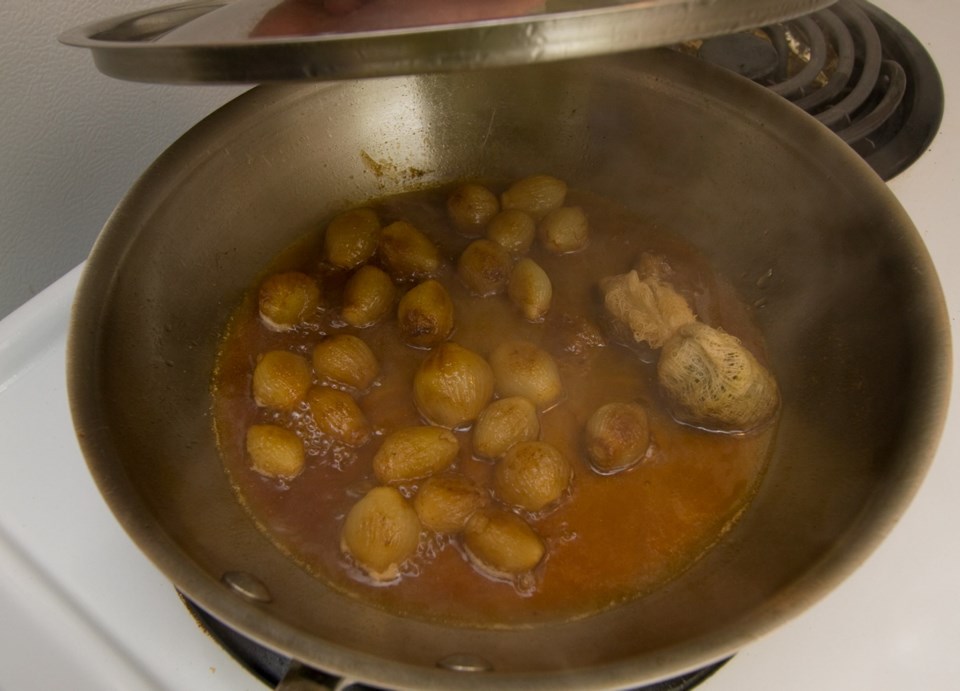 Dear Eric: I often make beef or chicken stock from bones and carcasses. I then freeze it to pull it out later to make soup. The other day, I pulled out the chicken stock I had made from Easter’s bird, made a delicious soup, ate some of it and then froze the leftovers for another meal or two.
Dear Eric: I often make beef or chicken stock from bones and carcasses. I then freeze it to pull it out later to make soup. The other day, I pulled out the chicken stock I had made from Easter’s bird, made a delicious soup, ate some of it and then froze the leftovers for another meal or two.
I then started thinking about the freeze/defrost cycles. Is it OK to freeze the stock, make the soup and then freeze the soup? Or should I make the stock, make the soup and then freeze the batches?
Leslie
��
Dear Leslie: In commercial and home kitchens I, too, have made stock, frozen it, thawed it, made soup with it, frozen that soup, and then thawed and reheated that soup at a later date. I’ve seen a host of other cooks do this, as well, and there’s never been an issue, as long as safe food practices were followed throughout the process.
According to several sources, when a food is frozen and kept in a properly working freezer at temperature of -18 C (0 F) or less, nothing is going to happen to the safety of it. In other words, harmful bacteria are not going to develop in these frigid conditions.
However, what freezing won’t do is kill any dangerous bacteria already in the food.
So if you’ve made stock and soup and did not take care when cooling, thawing and reheating it, and/or with the handling or quality of the ingredients used to make them, such as using foods beyond their best-before date, you could be freezing something that could make you ill when you do consume it.
On most government heath websites you’ll find a description of what’s called the “danger zone.” It’s a temperature range between 4 C and 60 C (40 F to 140 F) where bacteria multiply rapidly.
With such things as a chicken or turkey carcass leftover from a meal that I’ll make stock with, I’ll get the meat off it and the carcass in the refrigerator the moment it has cooled. Although it’s safe to store the carcass there a couple of days, I usually make stock with it the next day. It’s also a good idea to routinely check that the temperature in your refrigerator is below 4 C (40 F), that low point in the temperature danger zone.
When using the carcass to make stock, you don’t want to boil it rapidly, as that will create a cloudy, murky-looking stock, but you do want to make sure when cooking the liquid is simmering and above that 60 C (140 F) mark.
Simmering is a technique where foods cooked in liquids are kept just below the boiling point, around 100 C (212 F), where tiny bubbles just break on the surface of the liquid during cooking.
When your stock is made, you need to cool it before refrigerating or freezing. Some folks at home do that by simply by leaving the stock sitting out on the kitchen counter until cooled to room temperature. However, when you do that, particularly on a hot summer day, while it cools the stock could sit too long in that temperature “danger zone” and develop harmful bacteria.
That’s why I will, as is done in professional kitchens, more quickly and safely cool the stock by filling a sink with a mix of ice and cold water. I’ll then place a fine-mesh sieve over a clean stockpot and strain my hot stock into that pot. I’ll then set the pot of strained stock in the sink, adding more ice and cold water, if necessary, to match the level of the stock in the pot. I then allow the stock to cool to room temperature in the sink, stirring it gently every so often.
Using this method, the stock is usually chilled in 30 minutes, versus two or more hours if left sitting on my kitchen counter to cool.
Before freezing a meat stock, I usually refrigerate it long enough — usually overnight — to allow any fat that melted out of the carcass or bones to solidify on the surface, making it easier to remove.
When I freeze the stock, I’ll do so in airtight containers designed for the freezer and label and date them. Most sources say you can freeze stock up to three months. It’s not that the stock will go bad after that, but it will start to deteriorate in taste the longer it is kept.
When thawing the stock to make soup, the safest place to do it is in the refrigerator overnight, not on the kitchen counter where it could become warmer than 4 C (40 F) and be in that “danger zone” noted above. But if you need the stock right away, you could thaw it in the microwave.
When making soup with that stock, if you repeat all the food-safe practices noted above, the simmering, the cooling, etc., there will be no issues with freezing the soup.
Again, it’s not in a properly working freezer where a food will develop harmful bacteria, it’s in the steps along the way before the food gets frozen, and how you handle it once out of the freezer, where problems can occur.
For much more information on freezing and storing foods, a good resource I found is nchfp.uga.edu, the website for the University of Georgia’s The National Center for Home Food Preservation.
Eric Akis is the author of The Great Rotisserie Chicken Cookbook (Appetite by Random House). His columns appear in the Life section Wednesday and Sunday.



